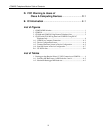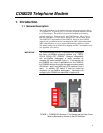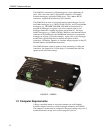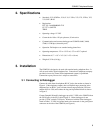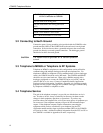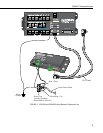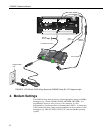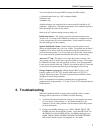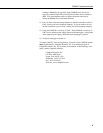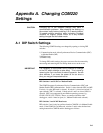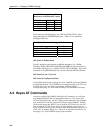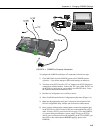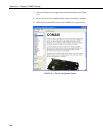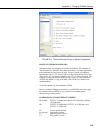
COM220 Telephone Modem
3) If using a non-PakBus datalogger (e.g., CR510, CR10X, CR23X, CR7,
CR5000), verify that DIP switch 1 on the COM220 is in the OPEN
(modem enable) position. For PakBus loggers (e.g., CR800, CR850,
CR1000, CR3000, CR10XPB, 23XPB, etc.), DIP switch 1 can be in either
position, but closed (SDC7) is preferred. See Appendix A.1 for details.
4) If the COM220 is set for Modem Enable (DIP switch 1 open), verify that
the ME baud rate selected (switches 3, 4) agrees with related
communication instructions in the datalogger program. Instructions for
setting the COM220’s ME baud rate are found in Appendix A.1.
5) If the COM220 is set for Modem Enable (DIP switch 1 open) and you are
unable to connect to the datalogger, try setting the datalogger BaudrateME
to a negative number (e.g. -9600) in order to enable auto-bauding in the
datalogger. If the datalogger BaudrateME is positive (due to an earlier
program instruction or Status Table configuration) the datalogger will be
unable to communicate with the COM220 unless baud rates happen to
match. A good rule of thumb is to keep baud rates negative (-) in
programs and when configuring the Status Table to allow datalogger
auto-bauding.
6) If unable to connect to a datalogger via the COM220, make sure that the
datalogger is not beaconing to the same port for which the COM220 is
configured (e.g., if the COM220 is configured for SDC7 and the
datalogger's BeaconSDC7 is set to something other than 0, then a
connection cannot be established).
7) If the COM220 is in Modem Enable mode, verify that the COM220 is the
only Modem Enable device connected to the datalogger. Other common
Campbell Scientific modem enable devices are the SC32B, some RF
modems, the MD485, the RF401, the SC932A, and the PDA-to-CS I/O
connector.
8) If the COM220 is in SDC mode (the default is SDC7, with DIP switch 1
closed and DIP switch 2 open), verify that any other SDC devices attached
to the datalogger are using a different SDC address (e.g., if the COM220
is configured for SDC7, another SDC device attached to the datalogger
must use SDC8).
9) Verify that no other software application is currently using the same COM
port on the computer. Even if a program is minimized in windows, it may
put a lock on a COM port. Some notebook computers do not
automatically activate the COM ports. Verify that the COM port you are
using is activated.
10) Use the Low Level Log in the Campbell Scientific software, LoggerNet,
[under Status Monitor, Tools, Log Tool, Options, View Low Level Log
(I/O)] to see connection progress as a link is being established. Assuming
the above items are O.K., the Low Level Log will display
“ATDT#######”. Where #### is the phone number entered in LoggerNet
Setup’s Phone Remote for the datalogger you are trying to call. The
modem attached to the computer will respond back to the computer with
result codes showing how the call is progressing. These responses should
include “RING” and “CONNECT ####” where #### is the negotiated
modem-to-modem connection baud rate. The maximum baud rate setting
8



